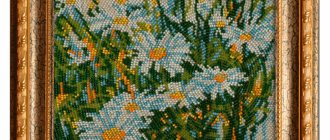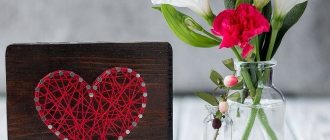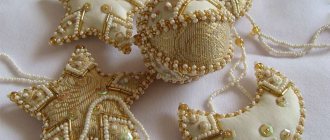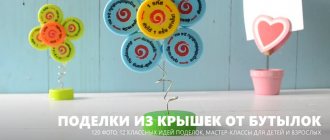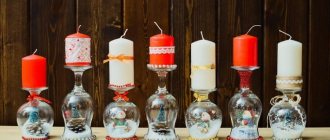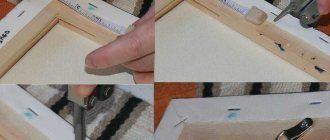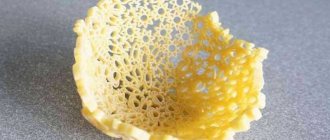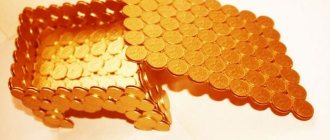Sometimes needlewomen are faced with a problem when a large number of small balls of thread or yarn remain, from which it is no longer possible to make anything worthwhile.
They often put all these skeins in a basket or bag, leaving them for the period when they finally figure out what to do with these small balls.
We confidently declare: after reading our article, you will no longer have to rack your brains over this issue, because we will provide you with several interesting ideas for using threads and yarn to decorate the interior of your own home with crafts made from woolen knitting threads and ordinary fine yarn.
What threads are used to create paintings?
Any thread will find its application when creating thread paintings, but each technique has its own preferences. For embroidery, silk and floss are most often used; knitted patterns are created from the remains of wool and synthetic yarn. For thread printing, thick textured threads are preferred; woolen yarn will be simply ideal; with its help you can not only “color” the drawing, but also give the picture volume.
Such works will definitely be unique and inimitable.
String-art does not require special threads - you can use any, depending on the idea. It will be easier for a beginner to work with thick threads. Thin threads require skill and craftsmanship, but with them you can create more complex and detailed designs and even achieve smooth color transitions. If you decide to work using the filumik technique, any thread will suit you, just use your imagination.
String Art is a fairly popular and unusual art that allows you to combine seemingly incompatible things: soft threads and hard nails.
Combining different techniques on one craft
You can combine several techniques on one craft and create a real masterpiece that will delight you with its attractiveness. To work, you will need two pieces of cardboard, green and yellow wool threads, PVA glue and a brush, a prepared template with a pattern of several dandelions:
- pompoms are formed from orange or bright yellow woolen threads; to make the composition more realistic, you can make 1-2 white balls;
- the silhouette of curly dandelion leaves is transferred to a separate piece of cardboard, covered first with glue, and then with cut green threads;
- the castings are cut out, their contours can be outlined with a dark green felt-tip pen, which will give the applique expressiveness, and they are glued to the general template;
- even sections of flower stems are covered with sequentially glued green threads; you can use sections or lay them in parallel;
- Instead of buds of blooming dandelion buds, yellow and white pom-poms made of woolen threads are glued onto a pre-prepared template.
By combining several techniques for making appliqués from threads, you can create designs with different themes, violets and peonies. Children's toys and pictures with naturalistic motifs (seashore and setting sun, forest clearing or fungus in the grass) turn out great on appliques.
A simple and easy master class is perfect for creating crafts using wool or embroidery threads. A source of inspiration can be various photos that are already completed and realized crafts, and even for a novice craftsman or child they are not difficult to repeat. Thanks to the technique of thread appliqué, you can make not only interesting crafts with your own hands, but also beautiful decorations for your home and interior transformation.
Tools needed to create paintings
Creating paintings from threads is a very democratic form of needlework; you probably already have everything you need in your home.
- The basis. For string-art, you can use wood, cork board or foam. In other techniques, the base can be cardboard, plastic, hardboard or glass.
- Drawing - this can be any printout, stencil, or your sketch made in pencil or paint.
At the moment, the popularity of unusual paintings made using the string art method is only growing.
The necessary tools and consumables vary somewhat depending on the technique used to create the painting.
For thread printing or flocking you will need:
- cardboard, glass or other rigid support;
- PVA glue, preferably thick;
- wooden skewer, toothpick or large needle for laying threads; It is convenient to use a brush for flocking;
- scissors and thread.
Nitcography in our country is popular, first of all, because of its low cost.
String-art:
- wooden or cork board, you can also use foam;
- small carnations (no more than 10-20 mm long) or pins with beads at the end (the beads will become an additional decoration);
- a small hammer for hammering nails and, of course, scissors and thread.
Works of art using the string art technique fit seamlessly into a modern interior.
Filumika is the most affordable way to create paintings from threads:
- the basis will be a photo frame with glass;
- fabric for the background and glue for fixing it to the base;
- scissors
- to “paint” a picture, we use everything that is left from your “big” needlework - trimmings of any threads, the smallest shreds, ribbons, remnants of lace, crystals, sequins, beads - your possibilities are limited only by your imagination.
The subjects of the paintings are made with threads and shreds, so the minimum cost and the result is an exclusive painting.
Learn to draw
For this technique of creating panels, you need to very finely cut the threads that will be used in the work. It should be remembered that the smaller the pieces of thread, the more beautiful and uniform the result will be. The creation principle is the same as described above. A drawing is applied to the cardboard, the main contours are made in contrasting colors, and the rest of the space, using threads and glue, is filled with pieces of threads. Of course, creating a panel will require patience and perseverance, but the result will be very similar to the real picture.
To create, you can attract little helpers; children will happily help adults and be proud of the results of their labors. A fluffy picture framed will be a good decorative element for a child's room.
Article on the topic: Asian spikelet with knitting needles: master class with knitting patterns
Where to find a drawing or diagram for a painting
For some techniques, for example, embroidery or string-art, you can buy ready-made kits for creating a picture from threads; you just need to select the proposed designs. If you have your own idea, you can find a suitable drawing on the Internet or make a sketch yourself. To work in the philumics technique, you don’t need a drawing for the base - you only need an idea and imagination, which can be fueled by a picture you like.
Paintings made from threads - threadography - is a type of fine art that uses lines and strokes as the main means of representation.
How to make a thread painting with your own hands
Here are simple step-by-step algorithms for creating a picture from threads.
Nitography:
- Place your chosen design under glass (if you used it as a basis) or transfer the contours of the image onto the base.
- The first step is to glue the outline with threads. Do not apply glue to the entire contour at once - work in small fragments. Press the threads firmly against the adhesive base and, if necessary, correct the outline with a stick.
- The second step is to fill the space between the laid contours with threads. The threads can be laid in a spiral or in strips. Try to pack them tighter.
- We fill in the background at the very end. The finished painting can be framed.
To create paintings from threads you need to prepare very few materials and tools.
String-art:
- Transfer the outlines of the drawing onto the base with a simple pencil
- Carefully hammer in the nails along the entire contour in small increments (about 10 mm or more often if the design requires it).
- Select a starting point and secure the thread to the nail. Wind the stretched thread around the hammered nails to create a pattern.
- When finished, secure the tip. If necessary, the nails can be driven deeper.
Such paintings are now in great demand.
Flocking:
- Transfer the image onto the base.
- Prepare the “paints” - finely chop the threads of the desired colors and place them in containers (plastic containers, cups or saucers).
- Coat the selected fragment of the pattern with glue and glue the thread crumbs. Move through the colors - move on to another color after you have done all the pieces of the first color. The background in this technique is done last.
Flocking is a method of applying very short (2-6 mm) fibers, called flocks, onto some kind of substrate such as fiberboard. fabric, cardboard, paper.
Philumica:
- In this technique, you do not need to transfer the drawing to the base; you can simply put an inspiring picture in front of your eyes or create directly “on the canvas”.
- Let's disassemble the selected frame and glue the fabric background onto the base (back wall of the frame).
- We lay out the prepared threads and shreds according to plan. The advantage of this technique is that you can experiment directly from the base without fear of ruining something. The best option will be the one you like.
- Cover the finished picture with glass and place it in a frame.
Scraps of various fabrics, threads, ribbons, lace, in general, everything that is necessary in sewing are used.
Decorative balls
One of the most popular ideas is balls made of threads of different thicknesses and colors. They can be made in various sizes, which will expand their scope of application.
Necessary materials:
- PVA glue;
- Any yarn;
- Balloon.
Instructions on how to make a craft from threads:
- Inflate the balloon to the required size.
- Pour some glue into a bowl.
- Dip the yarn into it.
- Wind threads soaked in glue around the inflated balloon in a random order.
- After the craft has dried, remove the unnecessary base, cut out the required holes and decorate to your liking.
Interesting examples of yarn paintings
All techniques are original and interesting. With their help, you can create real masterpieces worthy of exhibition halls. Create abstract paintings using string-art technique. Cartoon characters and stylized cats can be drawn well using threadography; fantasy flowers and landscapes can be laid out using the philumics technique. In all cases, thread paintings look very decorative and unusual.
Pictures made from yarn and threads are not just a picture in a frame on the wall. These techniques are used to create covers for notebooks, decorative vases and bottles, pillows, decorate box lids, and make postcards and gift boxes.
String art is not a new direction in needlework, but a very popular type of weaving from nails and threads.
Create, try, dare!
Drawing with threads is the same as drawing with a felt-tip pen, only the line needs to be glued to the base.
